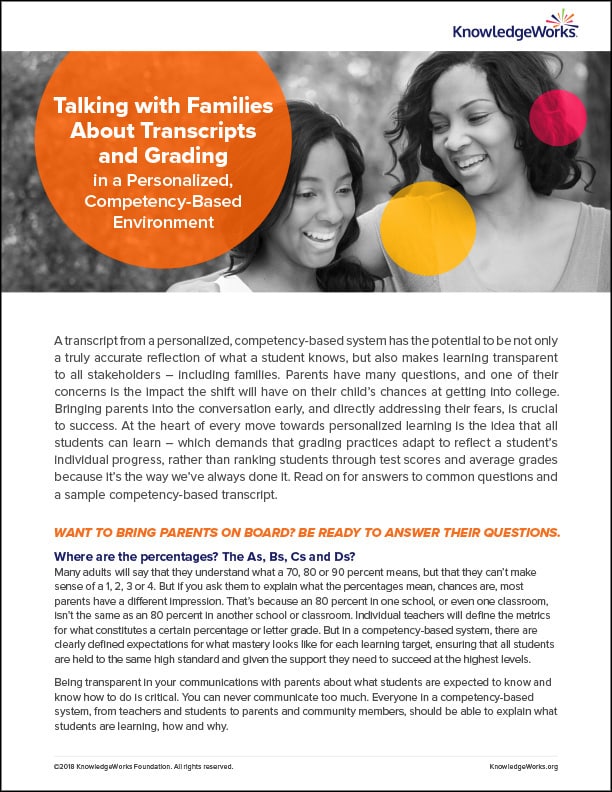 A transcript from a personalized, competency-based system has the potential to be not only a truly accurate reflection of what a student knows, but also makes learning transparent to all stakeholders – including families. Parents have many questions, and one of their concerns is the impact the shift will have on their child’s chances at getting into college.
A transcript from a personalized, competency-based system has the potential to be not only a truly accurate reflection of what a student knows, but also makes learning transparent to all stakeholders – including families. Parents have many questions, and one of their concerns is the impact the shift will have on their child’s chances at getting into college.
Bringing parents into the conversation early, and directly addressing their fears, is crucial to success. At the heart of every move towards personalized learning is the idea that all students can learn – which demands that grading practices adapt to reflect a student’s individual progress, rather than ranking students through test scores and average grades because it’s the way we’ve always done it. Read on for answers to common questions and a sample competency-based transcript.
Want to bring parents on board? Be ready to answer their questions.
Where are the percentages? The As, Bs, Cs and Ds?
Many adults will say that they understand what a 70, 80 or 90 percent means, but that they can’t make sense of a 1, 2, 3 or 4. But if you ask them to explain what the percentages mean, chances are, most parents have a different impression. That’s because an 80 percent in one school, or even one classroom, isn’t the same as an 80 percent in another school or classroom. Individual teachers will define the metrics for what constitutes a certain percentage or letter grade. But in a competency-based system, there are clearly defined expectations for what mastery looks like for each learning target, ensuring that all students are held to the same high standard and given the support they need to succeed at the highest levels.
Being transparent in your communications with parents about what students are expected to know and know how to do is critical. You can never communicate too much. Everyone in a competency-based system, from teachers and students to parents and community members, should be able to explain what students are learning, how and why.
Will colleges be able to make sense of a transcript that doesn’t include traditional grades or GPA information?
Colleges receive all kinds of transcripts: from students who have been homeschooled, from a variety of private schools and alternative schools and from applicants abroad. They’re used to variety. What many parents don’t realize is that every transcript is accompanied by a brief school profile. In the case of a competency-based environment, that profile is the place where the school can explain how to read the transcript and show the diversity and rigor of learning within their schools. Defining graduation requirements and what is required of students demonstrating mastery goes a long way toward making sense of the transcript for colleges and parents, so don’t hesitate to share this profile with your community, too.
Will a transcript from a competency-based environment negatively impact a student’s chances at getting into college?
Competency-based grading is not a deterrent to college acceptance. In fact, evidence of proficiency of state standards should be a strong indicator of college and career success. Because a transcript from a competency-based system is a true reflection of what a student has learned – there are no opportunities to boost a grade through participation, by bringing in boxes of tissues to the classroom or completing extra credit assignments. So rather than a single grade reflecting an entire year’s worth of work, colleges will have a greater picture of the student as a learner, showcasing what they’ve mastered, how they’ve applied their learning and how they’re brought their own interests and passions into it.
While a traditional transcript is often a reflection of a course a student has taken or an amount of work produced, a student’s scores on a competency-based transcript are a more complete reflection of what they know and know how to do.
What about merit-based scholarships?
Many scholarships will require a certain GPA or grade for a student to be considered, and again, the school profile is the place where a student’s scores can be explained. A competency-based environment also challenges traditional notions around student achievement. Class rank, for example, is a moving target. Rather than being in competition with their peers to graduate with honors or at the top of their class, competency-based grading systems honor a student’s individual achievements. It’s possible for more than 10 students, for example, to be in the top 10 at a competency-based school, because it’s not a competition, but rather a distinction based on what each student has accomplished and learned.
Students won’t get multiple opportunities to demonstrate mastery in college, or get to choose how they show what they know. How will they adjust?
In a competency-based environment, the goal is to graduate students who have the skills and knowledge they need to succeed no matter what their next steps are. Because students take greater ownership over how they’re demonstrating what they’re learning and regularly collaborate with their teachers and peers to extend their learning, they’re practicing many of the essential skills for success in any endeavor, college or professional career: critical thinking, self-awareness and self-regulation, strong communication and growth mindset. They’re ready for anything.





